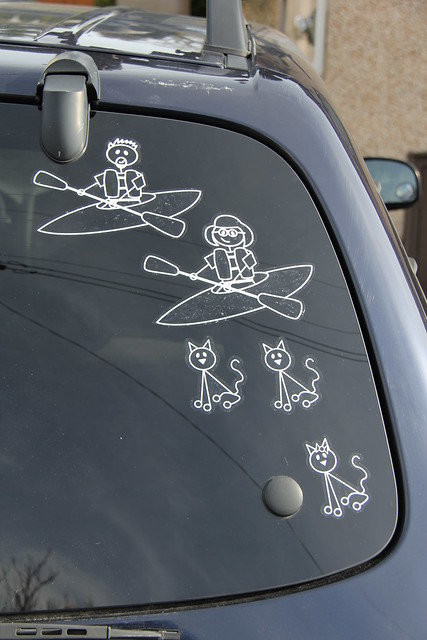Three local kayakers found themselves out in rough water yesterday as a paddle from Oak Bay Marina to Trial Island into 30 knot winds turned a little dicey. One kayaker stayed close to shore, but lost sight of the others who had rafted up, so he alerted rescue authorities. As it happened, the Oak Bay Rescue boat was nearby practising rough water kayak rescues with some paddlers from SISKA and was able to respond quickly. All ended well, except for one lost paddle.
One of those involved blogged about his experience, and here's his video of the rescue:
Sunday, February 26, 2012
Thursday, February 23, 2012
The 2012 MEC Paddlefest Victoria....
....will be on Saturday, June 30 at Willows Beach. Mark your calendars accordingly.
Under A Northern Sun
You never know what you'll find when exploring the Interweb.
Recently, I stumbled upon UNDERTHESUN, a blog by Canadian artist Roy Arden. Each entry in the blog is a series of old photographs. For instance entry 056 starts at the 1968 Mexico Olympics, veers into Neil Young, and ends up with various modes of rail transportation. But along the way there's some photos of old Inuit kayaks and baidarkas.
No info was offered on these pics, but check out his website. I spent a lazy Sunday afternoon strolling through it and there's some interesting stuff there.
Recently, I stumbled upon UNDERTHESUN, a blog by Canadian artist Roy Arden. Each entry in the blog is a series of old photographs. For instance entry 056 starts at the 1968 Mexico Olympics, veers into Neil Young, and ends up with various modes of rail transportation. But along the way there's some photos of old Inuit kayaks and baidarkas.
No info was offered on these pics, but check out his website. I spent a lazy Sunday afternoon strolling through it and there's some interesting stuff there.
Sunday, February 19, 2012
Friday, February 17, 2012
Victoria Paddle Festival
A reader named sonya stumbled upon my recent post noting that there will be no Vancouver Island Paddlefest this year. But she found a video suggesting that their will be a paddling event on the afternoon of March 10 along the Songhees waterfront on Victoria's harbour.
After a little Internet sleuthing, I found a website announcing the Victoria Paddle Festival. This event looks to be slipping in under the radar as I've not heard of it until now. From the website:
After a little Internet sleuthing, I found a website announcing the Victoria Paddle Festival. This event looks to be slipping in under the radar as I've not heard of it until now. From the website:
"The Victoria Paddle Festival is a celebration of adventure, science and education. This event aims to raise funds for OAR Northwest, a Canadian/American expedition ocean rowing team voyaging around Vancouver Island in April...Festival goers can test their skills on indoor rowing machines and try on the latest in nautical gear presented by Victoria’s local merchants. You can even view and climb OAR Northwest’s expedition craft, the world’s most technologically advanced ocean rowboat. Families will enjoy the chance to enter the silly model boat contest or sing along with sea shanties performed by local musicians. Finally, meet contemporary ocean rowers Jordan Hanssen, who rowed across the North-Atlantic Ocean in 2006, securing a Guinness World Record for his accomplishment. Speak with Adam Kreek and other Olympic medalists, as they share their passion for getting outside and experiencing the waterways."The OAR Northwest team will be rowing around in Vancouver Island in April, and then from Africa to America starting in May of this year. You can follow thier progress on their website.
Thursday, February 16, 2012
Another Ordinary Great Day
Yep! Got out on the water again this week, a couple of times. If you're stuck at a paying job all day long, don't envy me tooooo much. I'm a student again (or still) at fifty. But heck, you can envy me a little, so long as it's enough to get you out in your own kayak. Or you can do your own thing, preferably outdoors. That's fine by me. Just do whatever it is, don't envy me.
I've been out in the little inflatable again. Yes, it's only eight-and-a-half feet long, and the stroke is different for it than for a real sea kayak. You build me a recreational kayak about 12 feet long that weighs under forty pounds and I will carry that to the shore instead! In the meantime, I'm getting on the water with something I can swing around one-handed.
Most of the time when I'm out alone I go along the eastern shore of Cadboro Bay. That way, if Bernie has to come find me, he knows where to look. On Tuesday, he was home, so I told him I was going out along by the Royal Victoria Yacht Club for a change.
Not a bad day for going on the water, must say. The tide was way out. And on the boat ramp was a heavy half-ton pickup truck with a trailer loaded with smashed boat parts. Saanich Municipality was taking care of the boats abandoned on the shore after a couple of storms. Fibreglass might make nice boats but it sure makes troublesome garbage when the boats are wrecked...
As I paddled along the shore, I could hear workers hauling more boat pieces onto another trailer pulled by another truck. Boy, that sure made for a lot of traffic on the beach that afternoon! Two trucks? never seen the like.
I slid along the breakwater and into Loon Bay. Nice to drift here for a moment, send a SPOT okay message, and look around. No otters visible at the moment.
Then I paddled inside the breakwater, to pass between it and the yacht club. Boy, there are a lot of rocks in that breakwater! Big ones on top to stay put, but lots of medium-sized ones below that. We've seen otters dart into and between the stones on other days. This day I paddled along, seeing nothing special like that. Nothing till I got to the other end. There were some splotches of a reddish mold-like thing growing on a rock. I've got to look up what that is! And below it on another rock were some sea anemones.
Yup! I know what sea anemones look like. There weren't any here two or three years ago, when I was last here at a low tide. I got a good look at these, white and amber-coloured. Some were small, about as long as my thumb even when hanging down in mid-air. I've called those jelly shapes "jelly goobies" when we saw them at Thetis Island and also Brandon Islets in Nanaimo Harbour. There were some other white ones just below the surface, all closed up tight so it was hard to recognise them as sea anemones. And then below me, below the zero tide line that goes dry about twice a year, were three big white sea anemones, open like flowers.
So, it looks like about three years ago, a couple of anemones settled down on this end of the breakwater. And now they're raising a fine new generation. Lovely to think that the water's clean enough to support them here again! I've only seen sea anemones on the other shore of the bay, away from the yacht club.
Next to the little white ones under the surface were some white ribbons of jelly, about the same texture. A marine biologist told our paddle group that those were the eggs of nudibranchs (also called sea slugs). Wonderful to find new life in the places we've been paddling so many times.
Back to the beach, paddling happily with thoughts of little anemones and sea slugs. Nice to see the broken boats getting cleaned up! And a pair of young guys hauled a red canoe out from the bushes, pulled on PFDs, and paddled out to catch a fish. I like living in this neighbourhood.
I've been out in the little inflatable again. Yes, it's only eight-and-a-half feet long, and the stroke is different for it than for a real sea kayak. You build me a recreational kayak about 12 feet long that weighs under forty pounds and I will carry that to the shore instead! In the meantime, I'm getting on the water with something I can swing around one-handed.
Most of the time when I'm out alone I go along the eastern shore of Cadboro Bay. That way, if Bernie has to come find me, he knows where to look. On Tuesday, he was home, so I told him I was going out along by the Royal Victoria Yacht Club for a change.
Not a bad day for going on the water, must say. The tide was way out. And on the boat ramp was a heavy half-ton pickup truck with a trailer loaded with smashed boat parts. Saanich Municipality was taking care of the boats abandoned on the shore after a couple of storms. Fibreglass might make nice boats but it sure makes troublesome garbage when the boats are wrecked...
As I paddled along the shore, I could hear workers hauling more boat pieces onto another trailer pulled by another truck. Boy, that sure made for a lot of traffic on the beach that afternoon! Two trucks? never seen the like.
I slid along the breakwater and into Loon Bay. Nice to drift here for a moment, send a SPOT okay message, and look around. No otters visible at the moment.
Then I paddled inside the breakwater, to pass between it and the yacht club. Boy, there are a lot of rocks in that breakwater! Big ones on top to stay put, but lots of medium-sized ones below that. We've seen otters dart into and between the stones on other days. This day I paddled along, seeing nothing special like that. Nothing till I got to the other end. There were some splotches of a reddish mold-like thing growing on a rock. I've got to look up what that is! And below it on another rock were some sea anemones.
Yup! I know what sea anemones look like. There weren't any here two or three years ago, when I was last here at a low tide. I got a good look at these, white and amber-coloured. Some were small, about as long as my thumb even when hanging down in mid-air. I've called those jelly shapes "jelly goobies" when we saw them at Thetis Island and also Brandon Islets in Nanaimo Harbour. There were some other white ones just below the surface, all closed up tight so it was hard to recognise them as sea anemones. And then below me, below the zero tide line that goes dry about twice a year, were three big white sea anemones, open like flowers.
So, it looks like about three years ago, a couple of anemones settled down on this end of the breakwater. And now they're raising a fine new generation. Lovely to think that the water's clean enough to support them here again! I've only seen sea anemones on the other shore of the bay, away from the yacht club.
Next to the little white ones under the surface were some white ribbons of jelly, about the same texture. A marine biologist told our paddle group that those were the eggs of nudibranchs (also called sea slugs). Wonderful to find new life in the places we've been paddling so many times.
Back to the beach, paddling happily with thoughts of little anemones and sea slugs. Nice to see the broken boats getting cleaned up! And a pair of young guys hauled a red canoe out from the bushes, pulled on PFDs, and paddled out to catch a fish. I like living in this neighbourhood.
Saturday, February 11, 2012
Two Volcanoes, Three Ranges
It was a good paddle time on Sunday. I've been going flat out ever since, and had no time to post about it!
We went out kayaking in good ol' Cadboro Bay, same as a lot of times. But the different thing this time was being joined by Robyn and Mark from Gecko Paddler. Nice to have a larger group on the water, especially when we were hoping to cross Baynes Channel to visit the Chathams.
First off, when we launched we could see Mount Rainier dimly in the morning light. That was one volcano, showing up silhouetted against the sky at one end of the Olympic Mountains. It's not part of the Olympics, it's miles away south at the end of Puget Sound, but that cone does stick up a good ways.
We had a terrific show from an otter on the shore. He could see us drifting past in our boats, but decided not to worry about us. John and Mark drifted closer with their cameras, and got some marvelous photos. First the otter posed and primped, with his lovely tail draped over the log. Then he rolled on his back and scratched his shoulders against the rough log. Adorable little paws waved.
Once we were out past Flower Island, we could see Mount Baker bright with all its snow. That was the second volcano. And even some of the Cascade range was showing past the San Juan Islands.
The cold morning wasn't bothering us. Robyn and Louise were well-bundled up. With John's toque on under her hat, Louise kept the chill off nicely. But the breeze was stronger than expected for mid-morning. About two hours earlier than forecast, the breeze was picking up strength. We got part of the way across to Jemmy Jones Island before deciding not to do the crossing to Chatham.
Instead, we noodled along the shoreline to Cadboro Point. It was coming up on the end of the flood, so the freight train was slowing. There were no standing waves around the navigation light. We noodled around the rocks for a while, enjoying how the north breeze pushed in between the rocks and raised a few waves against the last of the flood current (less than 1 knot, so it was easy to cross.)
And there we could see just a bit of the Coast Mountain Range. So it was officially a two volcano day, and a three mountain range day. Not bad for a quiet paddle in home waters!
On the way back, I had to scoot ahead. The afternoon was booked for me, volunteering at the Elk/Beaver Lake Nature Centre. No time to write a post about the clear, cold air on this morning, or describe the Harlequin ducks Louise pointed out. Bright ducks, and chatty oystercatchers -- what good company we had on the water.
All week, I've been working on an assignment for a class in writing Literary Web Sites. Discovered each day that I was saving my work wrong. Each day, saved it a new way and was still wrong. Got help from the professor and still found new ways to save my work wrong. Finally a classmate showed me how to open and close the files properly in Dreamweaver. (give me simple blogspot wysiwyg anyday!) And now, I'm off to finish my assignment with all sorts of hot links and optimised images. It's not kayaking, but it's still fun.
We went out kayaking in good ol' Cadboro Bay, same as a lot of times. But the different thing this time was being joined by Robyn and Mark from Gecko Paddler. Nice to have a larger group on the water, especially when we were hoping to cross Baynes Channel to visit the Chathams.
First off, when we launched we could see Mount Rainier dimly in the morning light. That was one volcano, showing up silhouetted against the sky at one end of the Olympic Mountains. It's not part of the Olympics, it's miles away south at the end of Puget Sound, but that cone does stick up a good ways.
We had a terrific show from an otter on the shore. He could see us drifting past in our boats, but decided not to worry about us. John and Mark drifted closer with their cameras, and got some marvelous photos. First the otter posed and primped, with his lovely tail draped over the log. Then he rolled on his back and scratched his shoulders against the rough log. Adorable little paws waved.
Once we were out past Flower Island, we could see Mount Baker bright with all its snow. That was the second volcano. And even some of the Cascade range was showing past the San Juan Islands.
The cold morning wasn't bothering us. Robyn and Louise were well-bundled up. With John's toque on under her hat, Louise kept the chill off nicely. But the breeze was stronger than expected for mid-morning. About two hours earlier than forecast, the breeze was picking up strength. We got part of the way across to Jemmy Jones Island before deciding not to do the crossing to Chatham.
Instead, we noodled along the shoreline to Cadboro Point. It was coming up on the end of the flood, so the freight train was slowing. There were no standing waves around the navigation light. We noodled around the rocks for a while, enjoying how the north breeze pushed in between the rocks and raised a few waves against the last of the flood current (less than 1 knot, so it was easy to cross.)
And there we could see just a bit of the Coast Mountain Range. So it was officially a two volcano day, and a three mountain range day. Not bad for a quiet paddle in home waters!
On the way back, I had to scoot ahead. The afternoon was booked for me, volunteering at the Elk/Beaver Lake Nature Centre. No time to write a post about the clear, cold air on this morning, or describe the Harlequin ducks Louise pointed out. Bright ducks, and chatty oystercatchers -- what good company we had on the water.
All week, I've been working on an assignment for a class in writing Literary Web Sites. Discovered each day that I was saving my work wrong. Each day, saved it a new way and was still wrong. Got help from the professor and still found new ways to save my work wrong. Finally a classmate showed me how to open and close the files properly in Dreamweaver. (give me simple blogspot wysiwyg anyday!) And now, I'm off to finish my assignment with all sorts of hot links and optimised images. It's not kayaking, but it's still fun.
Friday, February 10, 2012
The Camera I
I’m taking a photography course, Introduction to Photography. Considering the number of pictures I’ve posted on this blog, it may seem a little odd to take an Introductory course, but there is a method to my madness. (That’s what I keep telling my therapist, anyway.)
My camera has a whole bunch of settings and buttons that I really don’t understand very well. Like aperture. What’s an aperture? I remember there were times when my parents told me to “Shut your aperture!” when I was acting up as a child. And other times I remember schoolmates telling me to, “Blow it out your aperture!” So apparently there are when times my aperture should be closed, and other times open. You can see my confusion.
Anyway, the point is that to be a better photographer, I need to comprehend what all those buttons do. And while I have a general sense of the functions, I don’t have a lot of experience fiddling with them and really understanding the relationships between them.
Clearly, some of the things I’m learning are not going to apply to taking pictures in a kayak as they will on dry land. The first rule of taking better pictures on land is “use a tripod.” Not so easy to do in a kayak.
Let’s face it – when I’m in my kayak, my camera(s) are in fill auto mode, and with good reason. On land, the photographer can remain perfectly still and so can the subject in many cases. Even if you’re shooting wildlife, the subject could be sitting still and spatial relationship between wouldn’t change. Not so when you’re on the water of course. Even if that duck you’re photographing isn’t moving, it’s still floating. And so are you, both moving in three dimensions independently of each other. It’s hard enough to keep your subject in frame and in focus when on the water, never mind fiddling with all those other settings, all the while aware that your subject could fly off or swim away at any second. But there are times when nature and fate cooperate, when the eagle decides that he will allow you to approach slowly and doesn’t fly away. Or when the seal is just as curious about you as you are of him. Or when the clouds and the sky are just perfect and you have a moment or two to set up the shot. Hopefully I’ll learn how to take better pictures when I have those moments to prepare on the water.
This has also spurred me on to post a little more about photography on the blog, so expect the occasional dive into the technique of taking pictures from a kayak. Or my version of it, anyway.
Plus, it gives me a chance to show off the pictures I submit to the course for critique. Here's the first two, from a recent walk through Beacon Hill Park.
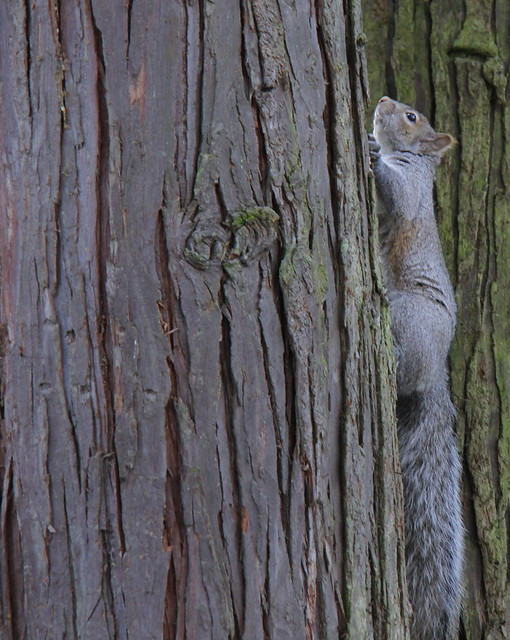
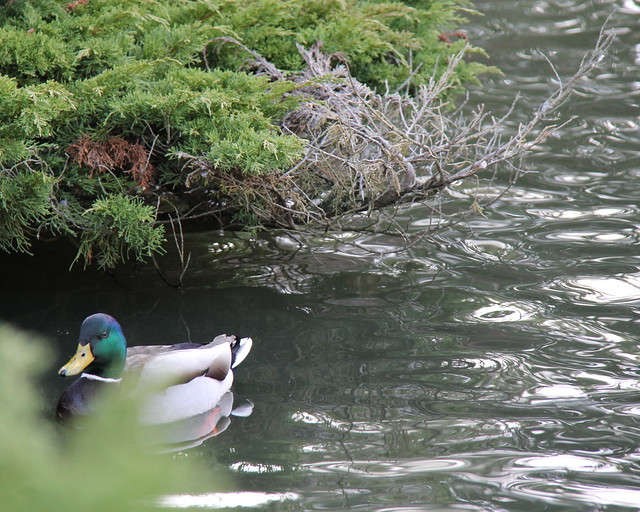
My camera has a whole bunch of settings and buttons that I really don’t understand very well. Like aperture. What’s an aperture? I remember there were times when my parents told me to “Shut your aperture!” when I was acting up as a child. And other times I remember schoolmates telling me to, “Blow it out your aperture!” So apparently there are when times my aperture should be closed, and other times open. You can see my confusion.
Anyway, the point is that to be a better photographer, I need to comprehend what all those buttons do. And while I have a general sense of the functions, I don’t have a lot of experience fiddling with them and really understanding the relationships between them.
Clearly, some of the things I’m learning are not going to apply to taking pictures in a kayak as they will on dry land. The first rule of taking better pictures on land is “use a tripod.” Not so easy to do in a kayak.
Let’s face it – when I’m in my kayak, my camera(s) are in fill auto mode, and with good reason. On land, the photographer can remain perfectly still and so can the subject in many cases. Even if you’re shooting wildlife, the subject could be sitting still and spatial relationship between wouldn’t change. Not so when you’re on the water of course. Even if that duck you’re photographing isn’t moving, it’s still floating. And so are you, both moving in three dimensions independently of each other. It’s hard enough to keep your subject in frame and in focus when on the water, never mind fiddling with all those other settings, all the while aware that your subject could fly off or swim away at any second. But there are times when nature and fate cooperate, when the eagle decides that he will allow you to approach slowly and doesn’t fly away. Or when the seal is just as curious about you as you are of him. Or when the clouds and the sky are just perfect and you have a moment or two to set up the shot. Hopefully I’ll learn how to take better pictures when I have those moments to prepare on the water.
This has also spurred me on to post a little more about photography on the blog, so expect the occasional dive into the technique of taking pictures from a kayak. Or my version of it, anyway.
Plus, it gives me a chance to show off the pictures I submit to the course for critique. Here's the first two, from a recent walk through Beacon Hill Park.


Sunday, February 05, 2012
Out In The Blue
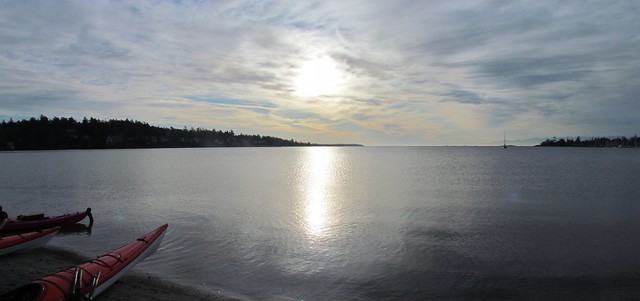
Sunday dawned a little cloudier and cooler than we had hoped, but the sun was poking through a light cloud cover. A slow flood and a slight north breeze suggested that we should have some nice conditions of the water. The breeze was forecast to pick up around noon as a squall passed through so we should have had a couple of hours of calm if cool conditions.

Louise and I met up early with Paula for a paddle at Cadboro Bay, joined by Mark and Robyn from Gecko Paddler. They're new to kayaking, but the bug has bit them hard. They purchased their kayaks last fall, and jumped right into paddling with both feet.
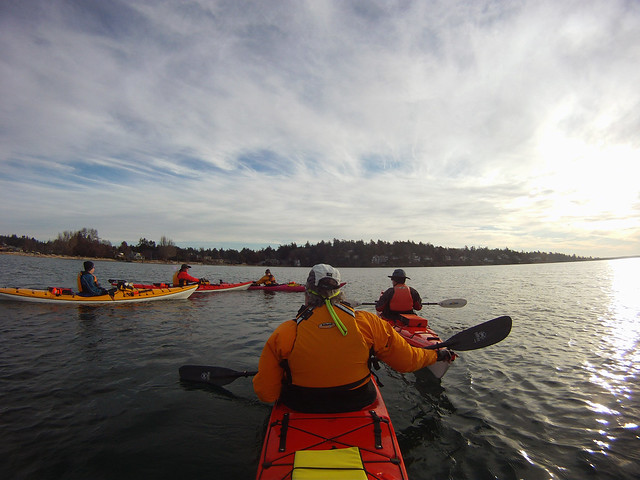
Our plan was to paddle out of Cadboro Bay, island hop to Flower and Jemmy Jones, then cross to Chatham Island....

...but on the way Mark spotted an otter relaxing on the shore.


We avoided the sail boats...

...but as we headed across, the 12 o'clock squall roared in about two hours early, so we decided to turn back. We saw the eagle that usually sits in the tree on the island joined by another eagle. Some sort of eagle ruckus ensued. Louise was the closest and had the best view. She was pretty sure that they had been mating. Here they are enjoying the afterglow.
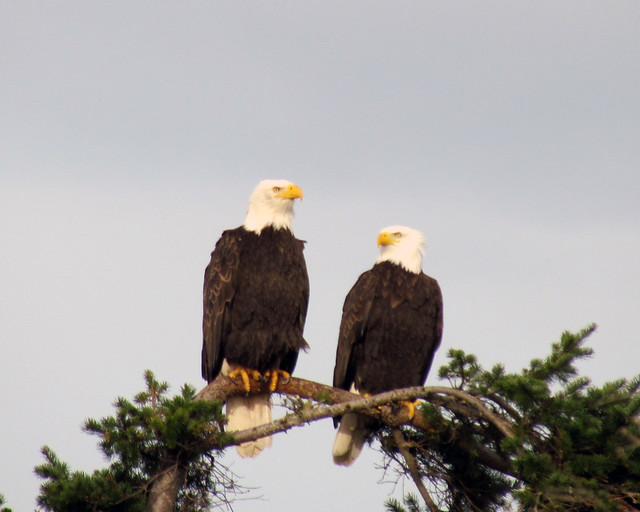
So instead of crossing, we continued up to Cadboro Point. While quite calm along the shore, we could see that the exposed northern shore around the point was getting the full blast of the wind. So we just paddled around the rocks at the end of the point, and Mark had his first taste of paddling in waves.
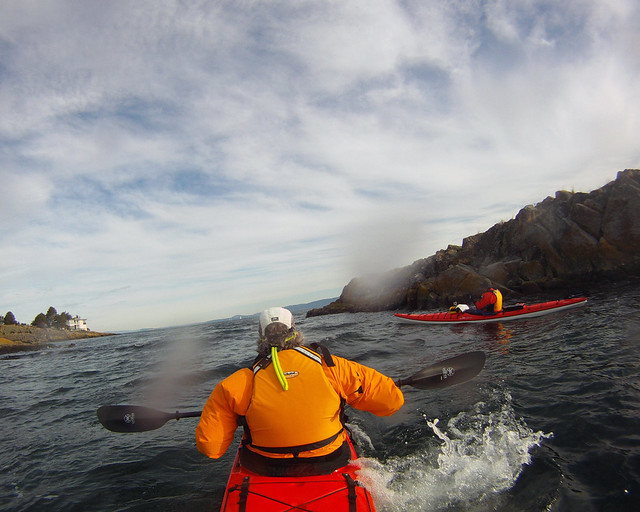
I think he liked it - he said he should get himself a surfing boat!
We headed back...
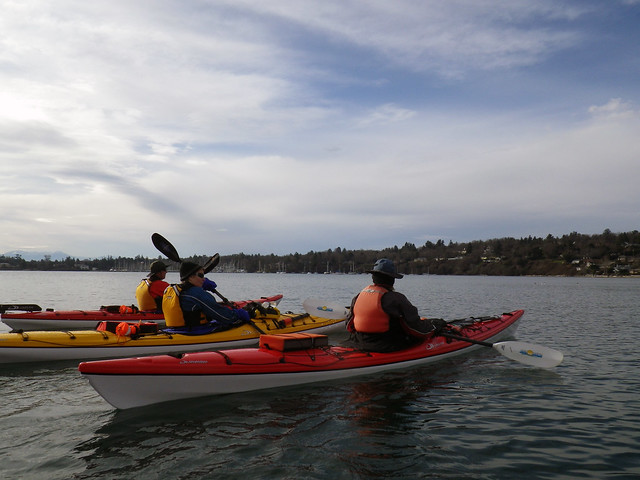
...and naturally the wind died off and the sun came out as soon as we hit the beach, but at least we were now able to enjoy our-post paddle coffee with Robyn and Mark at an outside table.
Trip Length: 7.29 km
YTD: 10.57 km
More pictures are here.


Fearless
Most of us can't remember all the things we've done during the course of a whole year, but when it comes to 2009, Freya Hoffmeister shouldn't have that problem because during that year she essentially did only one thing: she kayaked around Australia. Staring in January of that year, she paddled nearly 14,000 km and became the second person to circumnavigate Australia by kayak, completing the journey in 332 days, beating the record of Paul Caffyn, the first person to complete the trip, by almost a month.
Joe Glickson's account of Freya's trip is an engaging and enjoyable read, although it must be said that Joe seems almost pathologically determined to mention every time that she paddled topless. Which was apparently quite a bit.
While Joe is able to describe the details of Freya's expedition, he is by his own admission much less successful when describing Freya who at times seems to be a reticent subject. We learn that she's, well, fearless, but we spend precious little time behind the façade of the so-called Woman in Black. But while insights into why a person would want to spend a year of their life on such a journey are few, the details are fully covered, and there's no question that Freya accomplishment was amazing. And the book's pretty good, too.
And what is Freya doing for an encore? Currently she's kayaking around South America. Follow her adventure here.
Joe Glickson's account of Freya's trip is an engaging and enjoyable read, although it must be said that Joe seems almost pathologically determined to mention every time that she paddled topless. Which was apparently quite a bit.
While Joe is able to describe the details of Freya's expedition, he is by his own admission much less successful when describing Freya who at times seems to be a reticent subject. We learn that she's, well, fearless, but we spend precious little time behind the façade of the so-called Woman in Black. But while insights into why a person would want to spend a year of their life on such a journey are few, the details are fully covered, and there's no question that Freya accomplishment was amazing. And the book's pretty good, too.
And what is Freya doing for an encore? Currently she's kayaking around South America. Follow her adventure here.
Thursday, February 02, 2012
Eric Soares Passes Away
Eric Soares, a co-founder of the Tsunami Rangers, has died after suffering an aneurysm following a ski accident. A Facebook post by Sea Kayaker magazine notes that "Eric was well known around the world for the extreme coastal kayaking he did with the Tsunami Rangers and for his many contributions to the kayaking community. He wrote several articles for Sea Kayaker on surf, safety and teamwork. In his most recent article for us, “A Change of Heart” (SK August 2008), Eric wrote of surviving an aortic dissection and the changes that brought to his life. While his physical heart was flawed, his true heart was not. Eric had extraordinary and infectious energy."
Although I don't go for rough water kayaking myself, I read and enjoyed his latest book Confessions of a Wave Warrior, and he was kind enough to post a brief comment on my review.
The comments section of his final blog post has turned into a memorial wall as paddlers from around the world remember Eric. His death is a huge loss and another tough blow to the kayaking community this week.
(photo from tsunamirangers.com)
Although I don't go for rough water kayaking myself, I read and enjoyed his latest book Confessions of a Wave Warrior, and he was kind enough to post a brief comment on my review.
The comments section of his final blog post has turned into a memorial wall as paddlers from around the world remember Eric. His death is a huge loss and another tough blow to the kayaking community this week.
(photo from tsunamirangers.com)
Wednesday, February 01, 2012
Linkapalooza
Check this out...some surfers hit the waves at Bondi Beach decked out in TRON-styled wetsuits and surfboards.
But on the other hand, do sharks really need the extra help the lights will give them?
Of course, you don't to be surfing to see strange things on the water. Have you ever been kayaking out in the middle of nowhere when a dog has swam up to you? Check out this video:
Sadly, the story does not have a happy ending for the dog's owner.
This is Sean Morley playing in the big surf. He knows how to paddle fast; he recently held the record for fastest circumnavigation around Vancouver Island. Here, he gives tips on developing your forward stroke.
It turns out that everyone is working for the weekend -- even tornadoes. They and hailstorms occur at a rate of 20% below average on weekends, and 20% above average on work days. According to a recent study (as paraphrased by National Geographic), "This connection hints that pollution might help breed storms, the study authors say. That's because moisture gathers around specks of pollutants, which leads to more cloud droplets. Computer models suggest these droplets get lofted up to higher, colder air, leading to more plentiful and larger hail."
So there you go -- one less thing to worry about when out on your weekend paddle...
...although you may want to watch out for strange metal balls falling out of the sky.
But on the other hand, do sharks really need the extra help the lights will give them?
Of course, you don't to be surfing to see strange things on the water. Have you ever been kayaking out in the middle of nowhere when a dog has swam up to you? Check out this video:
Sadly, the story does not have a happy ending for the dog's owner.
This is Sean Morley playing in the big surf. He knows how to paddle fast; he recently held the record for fastest circumnavigation around Vancouver Island. Here, he gives tips on developing your forward stroke.
It turns out that everyone is working for the weekend -- even tornadoes. They and hailstorms occur at a rate of 20% below average on weekends, and 20% above average on work days. According to a recent study (as paraphrased by National Geographic), "This connection hints that pollution might help breed storms, the study authors say. That's because moisture gathers around specks of pollutants, which leads to more cloud droplets. Computer models suggest these droplets get lofted up to higher, colder air, leading to more plentiful and larger hail."
So there you go -- one less thing to worry about when out on your weekend paddle...
...although you may want to watch out for strange metal balls falling out of the sky.
Subscribe to:
Posts (Atom)





